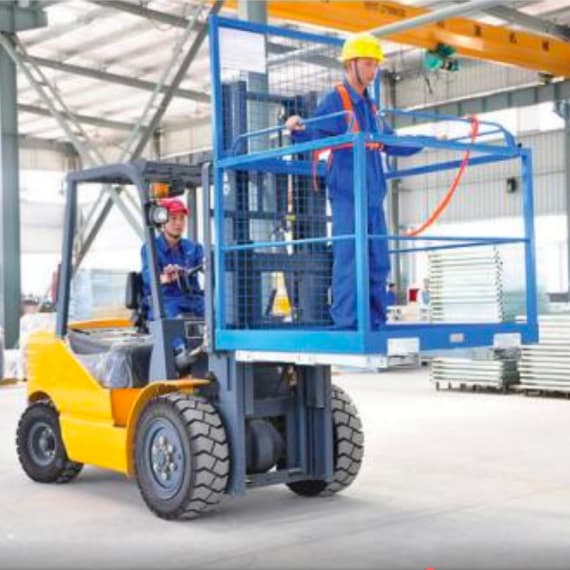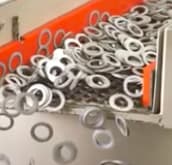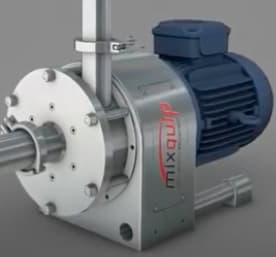UNDERSTANDING FORK TRUCK WORK PLATFORM REQUIREMENTS

Most people think they can just buy a work platform and fit it to any forklift. The fact is that the Australian Standards have very strict rules in relation to work platforms, explains Ross Grassick of Lencrow Materials Handling.
Australian Standards are very particular on the tasks for which a work platform can be used. In brief, these only cover situations where it is necessary to elevate personnel to perform special tasks for short duration and where it is not practicable to use a scaffold or equipment designed for people, such as a scissor lift. They go on to add they may not be used for production work or stocktaking.
A counterbalance forklift must have a capacity of 1800kg at 600mm load centre at maximum lift or five-times the combined mass of platform and rated load, whichever is greater.
For a reach truck (with mast or fork arms fully retracted) or a straddle truck the minimum capacity is 1000kg or three-times the combined mass of platform and rated load, whichever is greater.
Work platforms may not be used with pedestrian operated forklifts.
Forklifts use hydraulic rams to suspend the load and require a flow control valve to be fitted that will limit the descent rate to 0.6m/s, and this must be rated with full capacity load.
The platform must conform to Australian Standards, which include safety fences and toe guards as well, and a 2m mesh back to protect people from forklift mast operations. The forks must be fitted to two tunnels connected to the platform and the forks must be anchored at two independent points. The platform must be fitted with warning notice fitted to the rear of cage that can be seen by all occupants. (This is just a brief overview of the platform: there are detailed explanations within the Australian Standards.)
The forklift must also be fitted with a mechanical lockout that will only allow the operation of up and down movements when work platform is being used. This must actively stop the use of all other functions.
The forklift must also have the work platform shown on the rating plate, noting the unit has been tested for the use of a work platform, and the serial number of the work platform must be noted on the plate as well.
The operator requirements are strict and require the operator to hold a current licence that is appropriate for the equipment being operated. The requirements are covered in the following list from Australian Standard AS2359.2 2013.
3.10.2 Operator requirements
Where work platforms supported by truck are being used to elevate personnel, the operator shall observe the following safety requirements:
a. The pre-operational checks listed in clause 3.2 shall be carried out immediately prior to lifting and supporting of any personnel. This includes checking for the work platform.
b. The truck shall be used on hard level surface.
c. Any stabilizers shall be engaged prior to lifting.
d. The travel controls shall be in neutral position with parking brake engaged.
e. The mast if adjustable shall be set in a vertical position.
f. The fork arms shall be set in a horizontal position.
g. The hydraulic controls other than the lowering and lifting controls shall be locked out (by physical latching or other suitable means) to prevent the operation of these controls of functions, such as tilt and side shift.
h. A work platform shall not be used when the truck is fitted with a rotating attachment.
i. The operator and every person to be elevated shall check the platform is securely attached as per requirement.
j. The operator of the truck shall be in the normal operating position and remain in this position when using the work platform. Note the use of pedestrian operated trucks with work platforms is not permitted.
k. Operators of the truck shall keep their hands and feet clear of the controls other than those in use.
l. The operator shall keep clear of all overhead obstructions and in particular well clear of electrical conductors.
m. Before any person is elevated or supported by the work platform, the operator shall lift the platform to the required work height to confirm that all systems are functioning correctly.
n. The operator shall lift the and lower the work platform in a smooth manner.
o. The operator shall ensure that the elevated personnel are standing on the floor of the platform at all times they are elevated.
p. Ladders, the platform railings, or other means shall not be used to gain additional height.
q. Whenever a person is supported by the work platform, any manoeuvring of the truck shall be minimised. A person shall not be transported any distance by use of the platform.
The use of a work platform still requires the operator to put together a safe work method as well to communicate accurately with other staff involved in the operation to reduce the risk of accidents.
Lencrow Materials Handling
1300 536 279
www.lencrowforklifts.com.au






